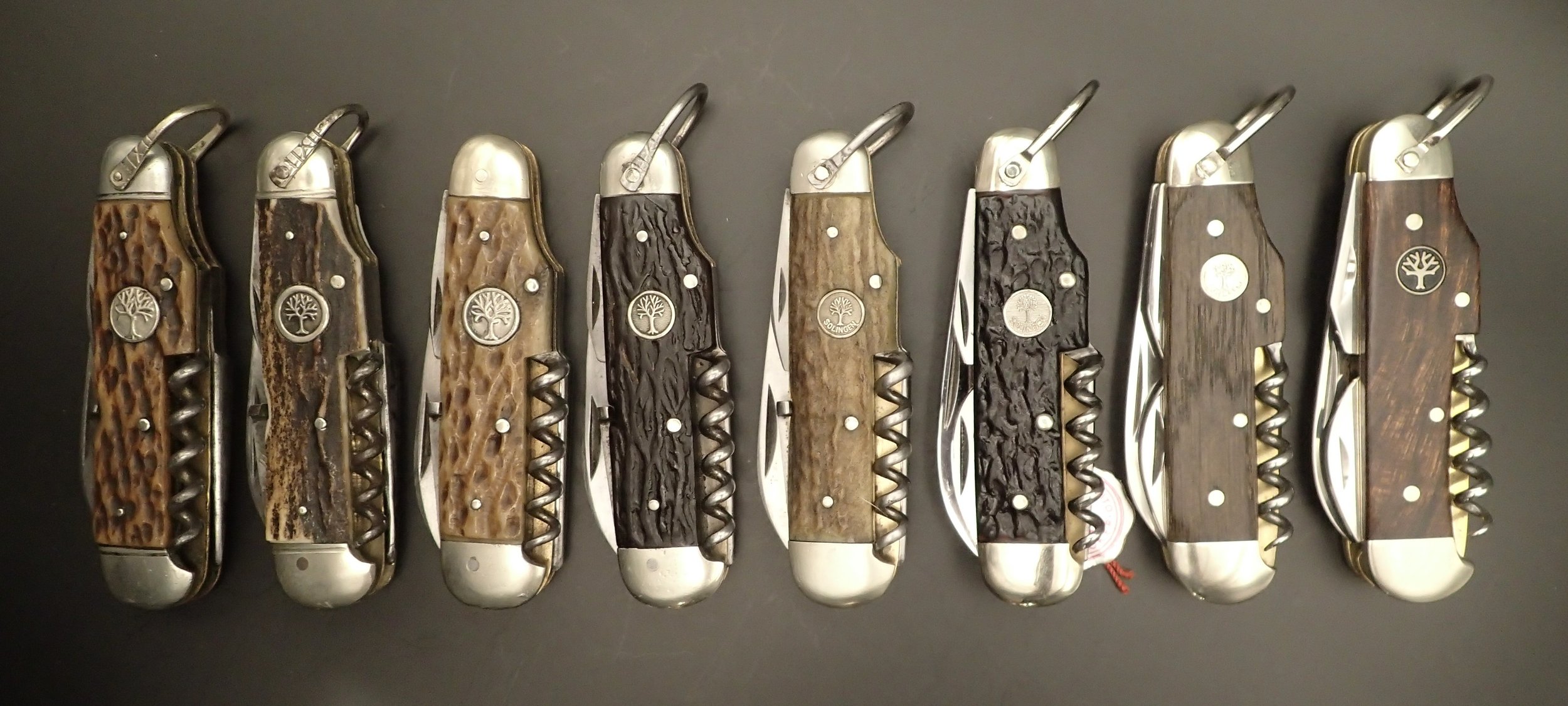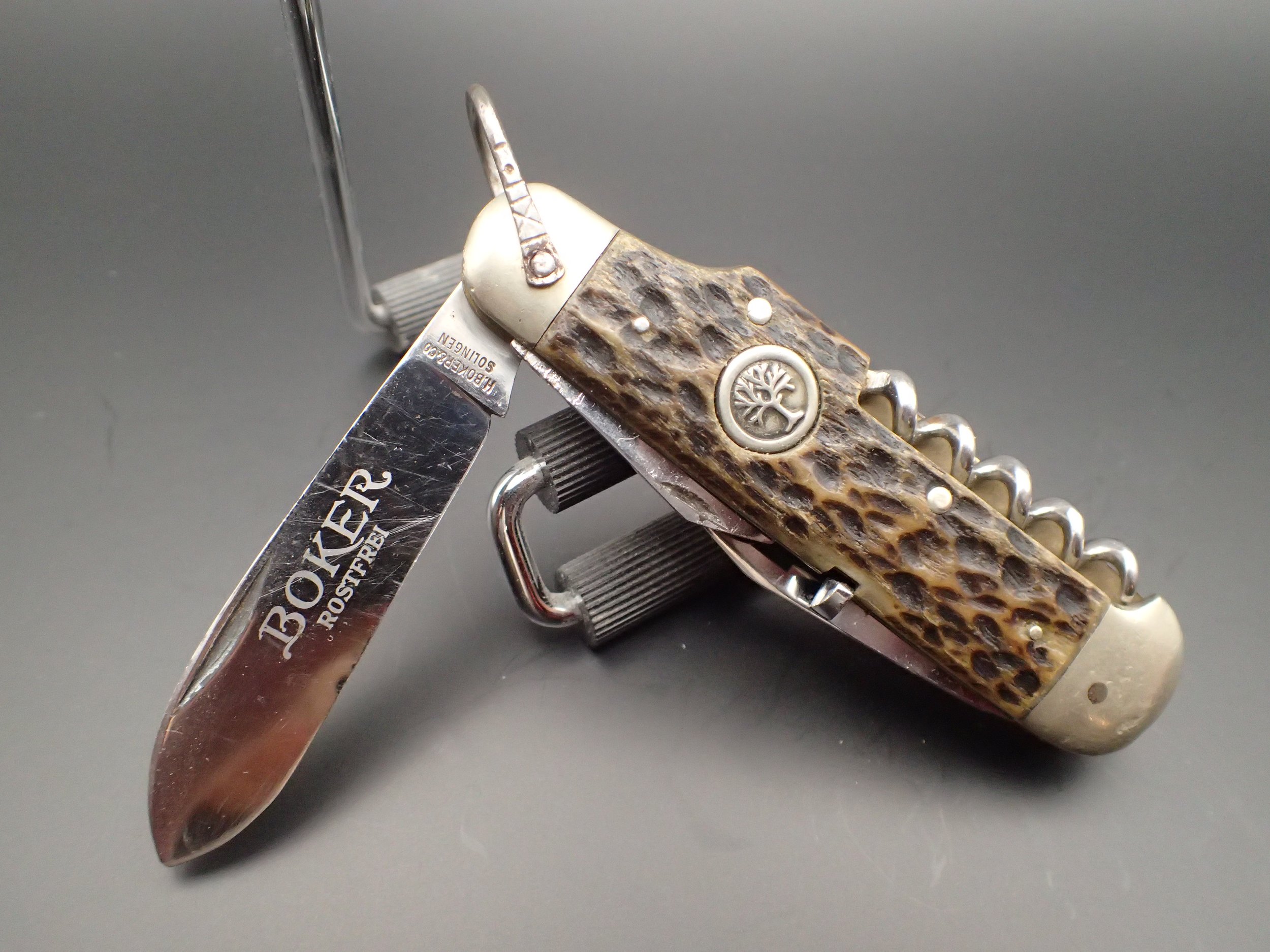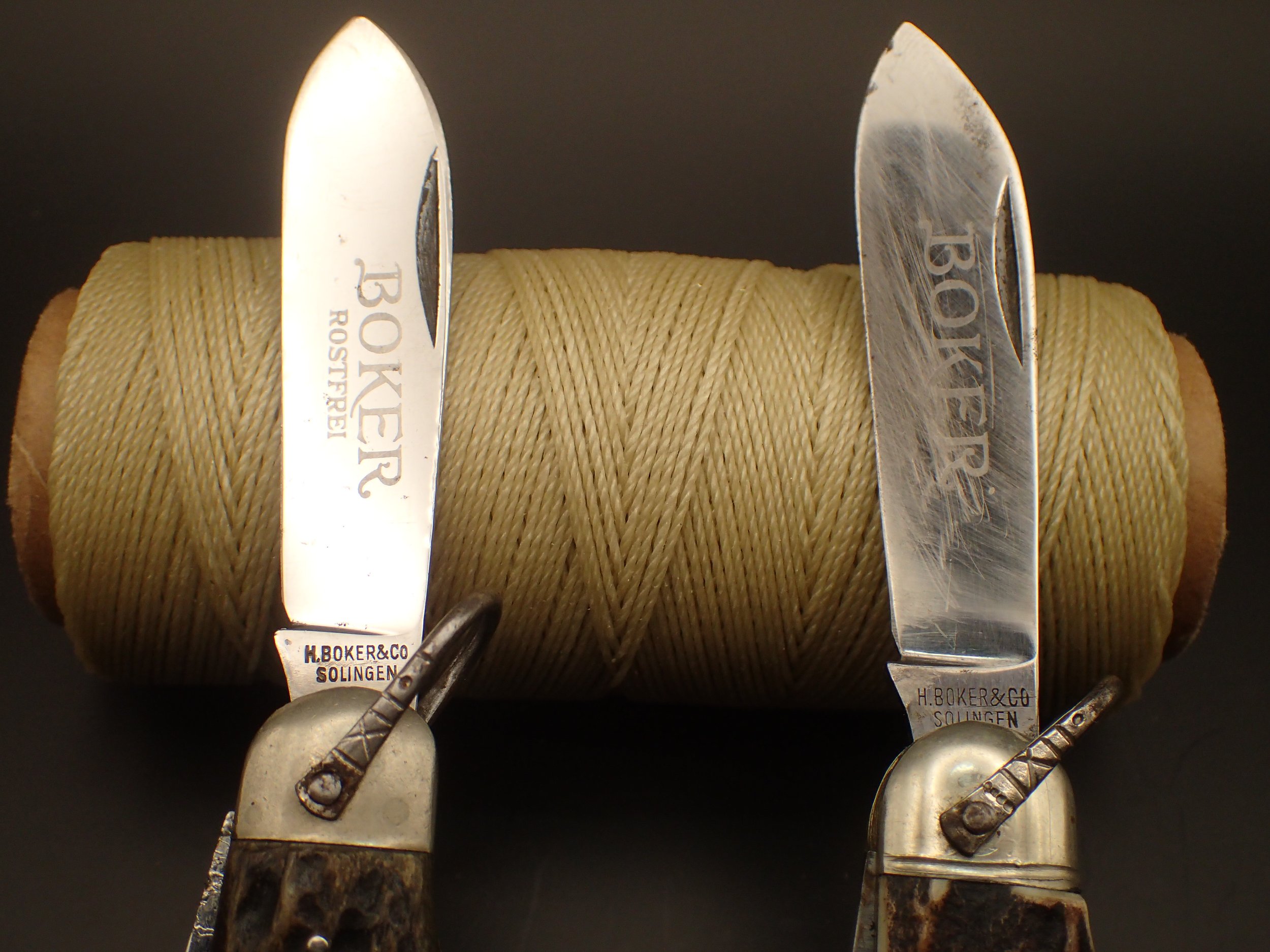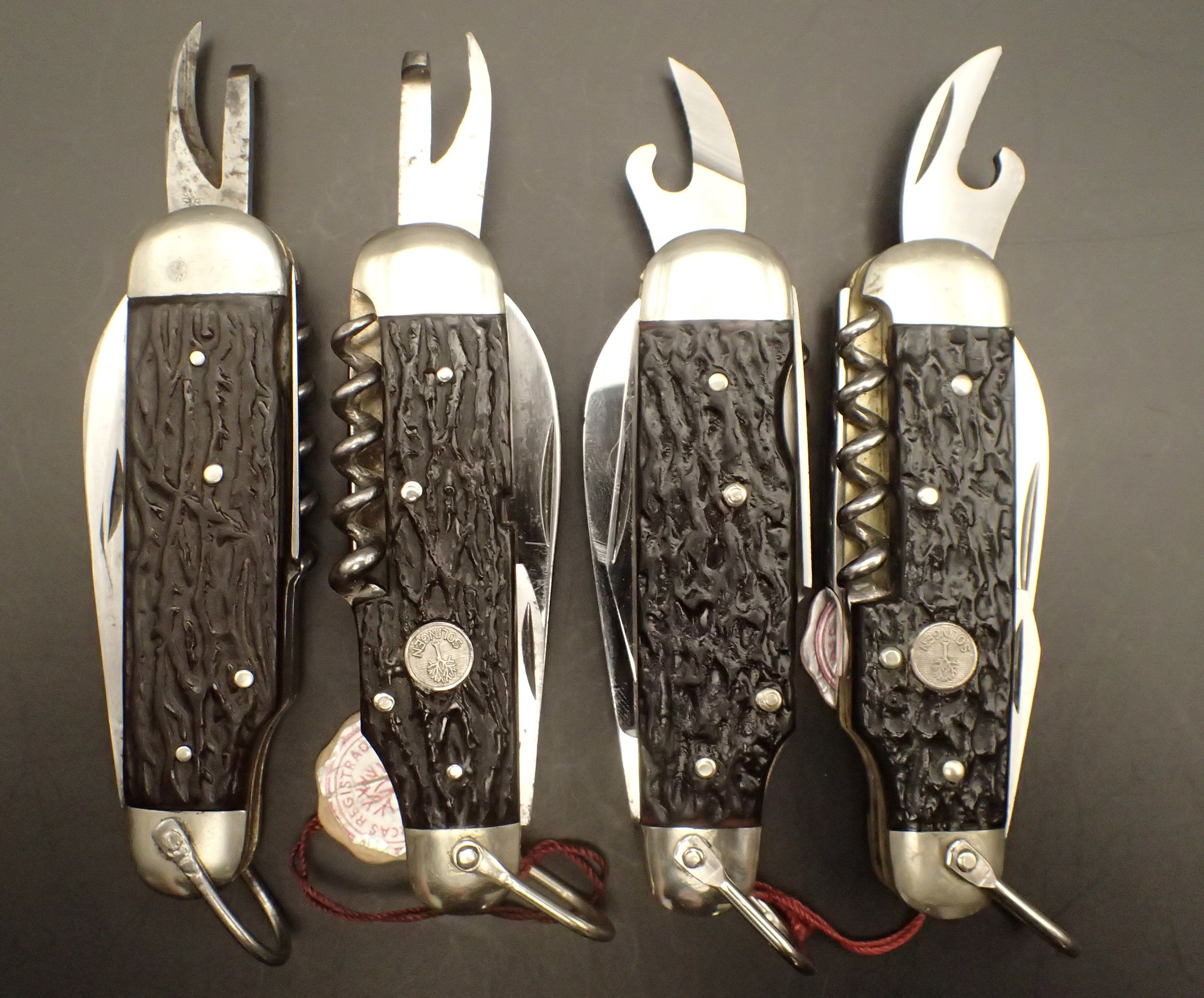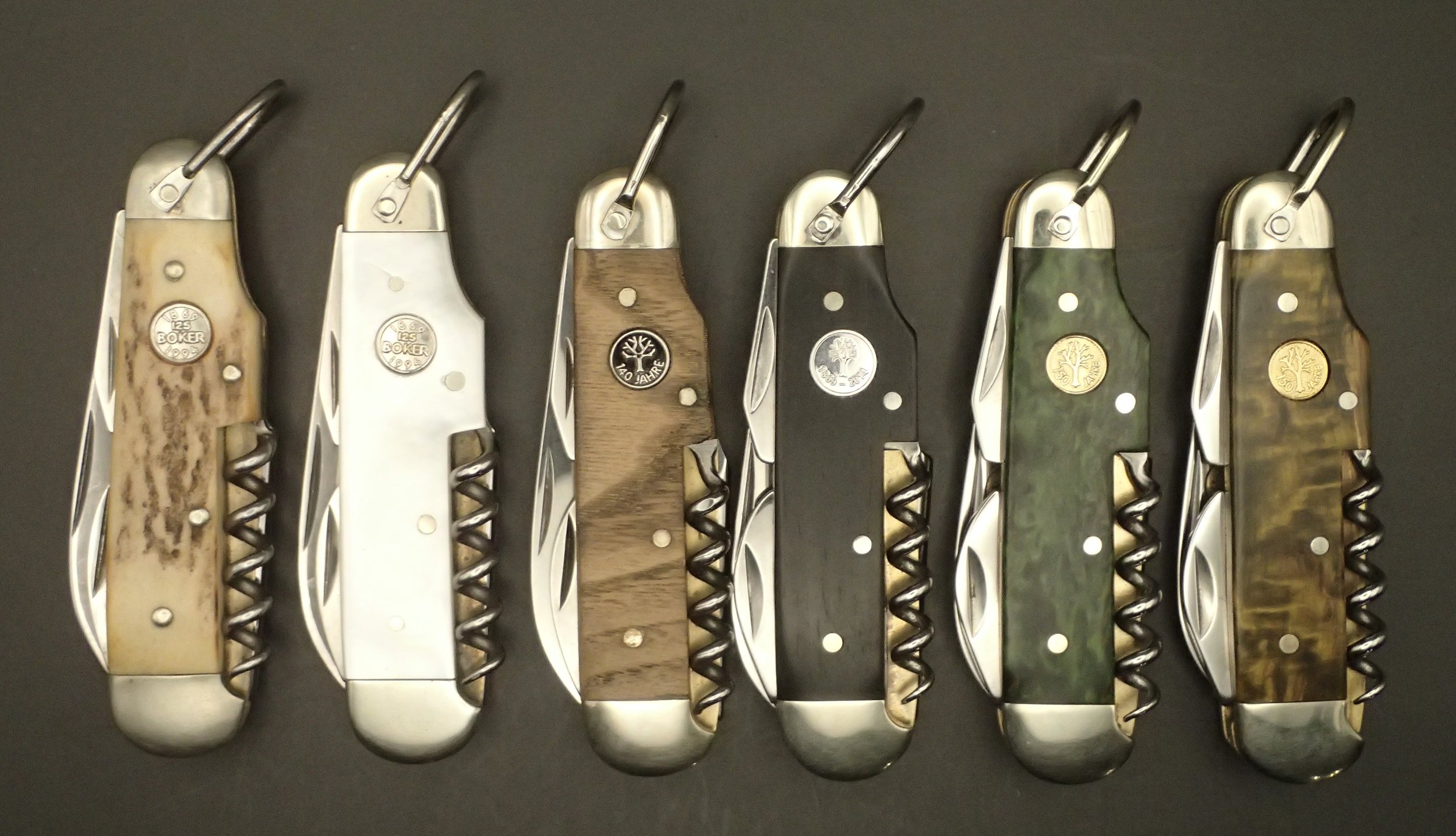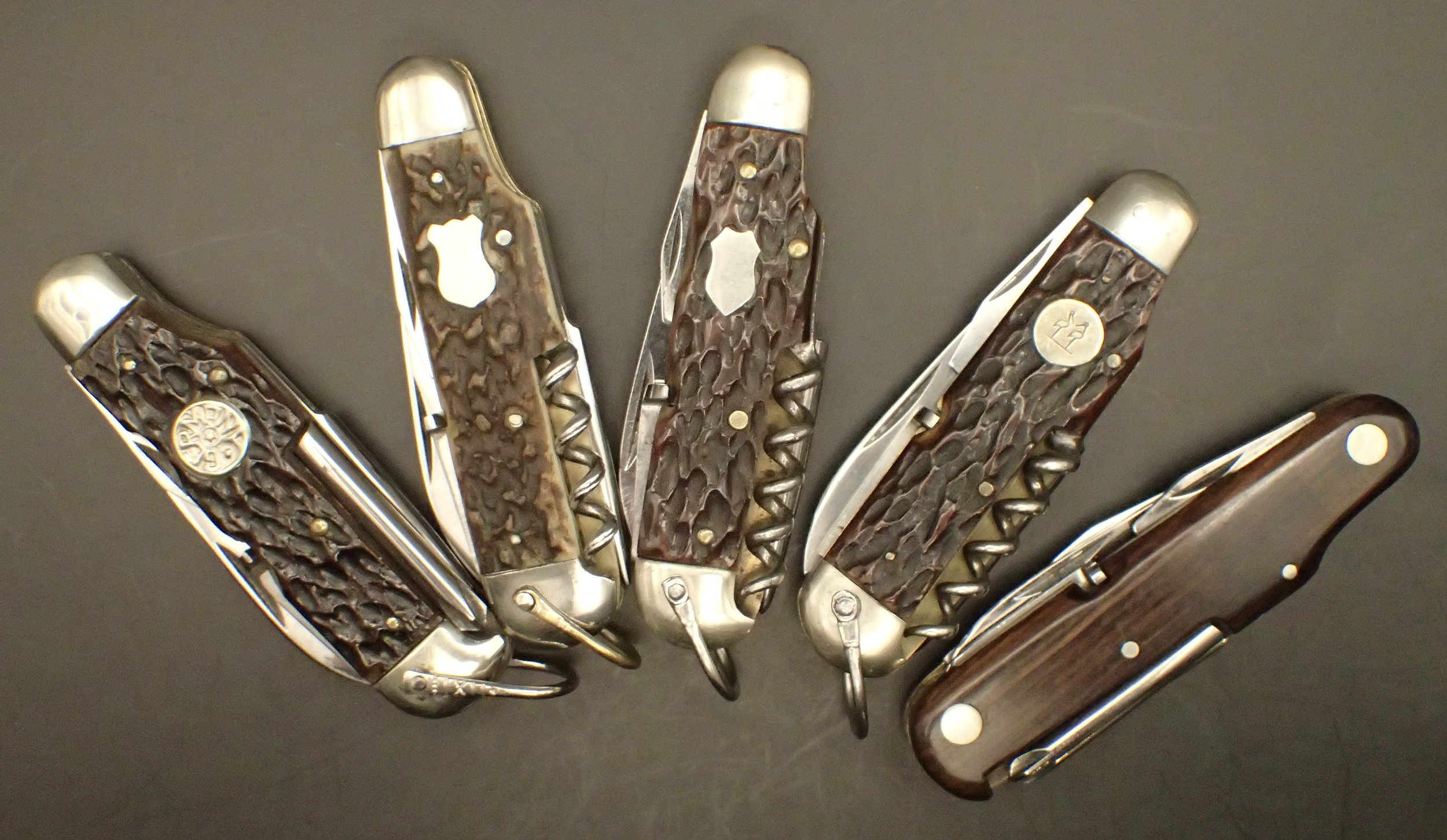Song of the Humpback, Part 2: the Sportmesser Turns 100.
Myron Erickson
Sportmesser, the most beautiful of the scout/camp knives.
Welcome to Part 2 of my one-part series on collecting the Böker 182 and other makes of sportmesser, the humpback 6-blade scout pattern pocket knife. If you arrived here via a search engine and haven’t yet read Part 1, you can find it here. In that article, I touched on the origins and history of the pattern, most notably the Remington R3843 and Böker 182, and discussed a few pointers for collectors. That article has proven popular, so I thought I’d revisit the topic and share what I’ve learned about these beautiful pocket knives in the year-and-a-half since I published it. Oh, and just a quick note on nomenclature — “sportmesser” is both singular and plural in German, so if you are exclusively anglophonic my grammar might seem a bit strange, but it’s correct. Just think of “deer” or “sheep” whenever my subject-verb agreement seems off. :)
From ca. the late-1920’s to the 2020’s, the Böker 182 spans nearly 100 years.
The sportmesser is turning 100 years old right about now, although no one knows for sure when. Since determining the age of any individual knife can be tricky, I thought it would be fun to observe the sportmesser centenary by documenting and sharing what I know (and what I don’t) on the subject of dating a vintage knife. Since Böker is the only maker who has been continuously producing the sportmesser since its beginnings, my comments on dating are focused on Böker knives. Finally, since the fun of being a sportmesser collector is the oxymoronic pursuit of finding variety within homogeneity, I’ll share a few of my own sportmesser rarities. Let’s begin at the beginning, the so-called pre-war period.
A ca. 1930’s 182 with blade etch. Only the blades are stainless; the other implements are chrome plated.
Pre-War Knives.
Perhaps one of the most common delineators you’ll come across as a collector of sportmesser is “pre-war,” by which people are referring to World War II. It’s an unfortunate fact that the Böker factory in Solingen was destroyed in the war, so any production records that may have existed were completely lost. I’m not sure what information there may have even been, but it seems reasonable to assume that technical drawings, catalogs, trademarks, and other things that would be useful to the collector today must have been among the materials lost forever.
Wedge-shaped spacer on a pre-war 182. Note lined bolsters paired with the stag scales.
With respect to the Böker 182, most collectors agree on a few telltale features in concluding likely pre-war construction. The shield style, the presence of a wedge-shaped spacer, and one of two tang stamps are generally the best indicators. But keep in mind these knives are 80-100 years old now, and thus have passed through any number of owners’ hands. That’s a lot of time for little things like shields and bails to come and go, and for big things like replacement blades from a donor knife to contribute misleading bread crumbs to the trail. When dating a knife, I always try to read the whole knife, and then place it in context with others already in my collection.
ca. 1920’s (maybe).
I believe that my oldest Böker sportmesser dates to the 1920’s. I base this hypothesis on the fact that it has very subtle differences that can be discerned when compared to the other pre-war Böker sportmesser in my collection. For example, the cap lifter and awl are a few millimeters longer, and the lower jaw of the can opener is shorter and thinner.
A very early 182, possibly from the 1920’s.
Perhaps most notably, its brass center liner has a coin edge visible on the inside and its virtually rimless shield depicts a tree with a prominent center taproot. And although it can be difficult to judge, the tree logo stamps on the blades and implements appear to be from the 1920’s as well. And finally, this knife has lined bolsters, which is uncommon in a 1930’s-40’s Böker sportmesser with jigged bone scales. This knife is just different than any other early 182 in my collection.
Note both the wedged spacer and the very delicate coining on the liner.
At the end of the day, of course, this is just speculation on my part. We know the Remington R3843 was advertised as early as 1928, and we know Remington hired away skilled Solingen-trained knife makers from Boker USA. Who’s to say that Hans at Boker USA didn’t bring “das sportmesser” design with him to Remington, it having been shared with him in a friendly letter from cousin Karl back at Solingen Böker? There is, however, a pretty wet blanket quenching my red hot hypothesis here. The evidence against my knife being from the 1920’s is the reproduction 1928 Böker catalog I have, which, conspicuously, doesn’t include the Model 182. Sigh… this mystery may never be solved.
ca. 1930’s-1940’s, The Classic Pre-War 182.
Knives from this era are the easiest pre-war specimens to find. They can be told by their thick-rimmed tree shield with the center taproot ranging from barely noticeable to almost absent. I have two knives from this era that have identical 1930’s-’40’s era three-line tang stamps and blade etches, but slightly different rims on their shields. One has the common thick rim but the other has a shield with a rim somewhere between the thick rim and the super-rare thin rim mentioned above. I call it the mid-rim, and it’s one of only a few I’ve seen.
Typical pre-war 182’s with thick-rimmed shields, wedge-shaped spacers, and decorated bails.
As mentioned above, the presence of the wedge-shaped spacer is a good identifier of knives from this era. Most of my 1930’s-’40’s era 182’s have unlined bolsters, but I have one that has lined bolsters. It also has beautiful stag scales, though, and I wonder if the two went together as features of a deluxe sportmesser.
Typical two-line tang stamps from 1930’s-40’s.
I have a few very special 182’s from this era. The fiber-scaled specimen I featured in Part 1 is a knife I’ve speculated was a war-time product. Including mine, I know of three of these rare 182’s in private collections, although I’m sure there are more. And then there is the jigged bone shadow pattern (i.e., no bolsters or bail) knife in my collection that shares its weird aluminum shield and steel pins with the fiber knife, so perhaps it comes from the same time.
A trio of rare 182’s from the pre-war period. L to R: fiber-scaled, shadow pattern, and bakelite with tree inlay.
The final rarity I have from this era is a bakelite-looking 182 with elongated tree logo inlay instead of a round shield. I’ve seen another in a private collection, the owner of which knew the knife’s provenance, and so knew it had been carried by a soldier in WWII. A quick search of YouTube reveals a restoration video of another one of these rare Solingen beauties. The beautiful tree logo inlay is still in use by Böker on some of their razor products today.
The rare bakelite-scaled 182 with tree inlay instead of shield.
The Mysterious Böker 582.
A Böker sportmesser with every appearance of the 182 appears in catalog cut sheets from the 1930’s. But what makes it unique and somewhat mysterious is that it is actually a model 582. I know of two of these knives, both in the collections of friends. What made the 582 unique, especially for its time, was its stainless steel implements. The best hypothesis I’ve heard is that the 582 designation served to distinguish it from its carbon steel stablemates. The 582 was built with other premium features, such as stag scales and lined bolsters.
Über-rare Böker 582. Image compliments Steve Loeff.
ca. 1950’s-1960’s: The post-war 182, 7593, & 7594.
The 182 underwent a fundamental change to its traditional construction during this era when Böker ceased using the wedge-shaped spacer. And there were several other notable changes to its features during this time. The side-opening can opener and the fancy/decorated bail both entered this era of the 182, but had disappeared by its end. The old style side-opening can opener remained a feature of the 182 until the early-mid-1960’s, when it transitioned to the more modern Mirando-style opener (i.e., the top-opening claw style familiar to just about everyone). The fancy/decorated bail disappeared at about the same time; its slightly plainer replacement appears to have also been handmade, but the enigmatic, hand-applied markings on the old decorated bail were gone for good.
Wedge-shaped spacer, mid-rimmed shield, three-line tang and beautiful blade etch. Early post-war is my best guess.
Sometime in the early-mid 1950’s, the thick-rimmed shield seems to have gone the way of the dodo. Böker 182’s from this period can be seen with two different shields, one less common than the other. Starting around the mid-1950’s a tree shield with background coining/lining and a moderate rim entered use. The tree featured a prominent tap root but no other words or symbols. It was in use for about 20 years, but it must’ve been used mostly on other Böker patterns because you don’t see many 182’s featuring it. The knife in my collection that has this shield also has a fancy/decorated bail that appears original, and “molded bone stag” scales, that ubiquitous handle material with a faux stag antler look and a very dark brown color.
Circa 1955-60 with no wedge-shaped spacer, lined no-word shield, decorated bail, three-line tang stamps, and molded bone stag.
Around 1960, the now-familiar tree shield with fine background lines and the word mark “SOLINGEN” under the tree appeared. In my experience, it is much more prevalent on 182’s from this period than the non-word-marked shield with which it overlapped. The word mark shield continued in use until 2020, when the bold new Böker shield replaced it.
Two molded bone stag 182’s. Note top knife has decorated bail and no-word shield. Bottom knife has mid-bail, word shield, and modern tang stamps.
The 7593/182.
For reasons I’ve never seen clearly explained, the 182 was sometimes marked as a 7593 during this period. I have two specimens, one very early post-war in lovely jigged bone scales, decorated bail, early three-line tang stamp, and wedge-shaped spacer. The other is obviously more modern, with the more pedestrian molded bone stag scales, mid-bail, and modern tang stamp. Both of my knives are marked with both model designators, 182 and 7593. It’s another sportmesser mystery I haven’t solved yet, but a plausible hypothesis is that Böker was transitioning the 182 to model number 7593 to differentiate it from the planned 7594. When the 7594 was discontinued, the 7593 designator was no longer needed.
Two 7593’s, one of which has pre-war characteristics.
The 7594.
This sportmesser was Böker’s 182 with a Phillips head screwdriver substituted for the cork screw. Crucially for the vintage Böker collector interested in the evolution of the species, examples of the 7594 are found with both styles of can opener, and the change must have happened somewhere between 1960 and ‘67 since 1960-’67 was the lifespan of the Böker 7594 in molded bone stag. Consistent with this logic is the fact that a 21 year patent on the Mirando opener would’ve expired around 1965.
Three 7594’s. L to R: red pyralin-scaled, molded bone stag with early can opener and late can opener.
Speaking of the 7594, collectors will want to keep an eye out for a rare variant of this knife that was produced with red pyralin scales. It was only made from 1956-’60, so is understandably scarce today. Most specimens you’ll see have lived a tough life and are experiencing shrinkage of the scales. Mine is missing its bail and someone has rounded a mm or two off the end of the Phillips head screwdriver. Still, I feel lucky to have one of these rare humpbacks.
ca. 1970’s-1980’s. The Brownie Evolves.
If you have a basic familiarity with the Böker 182 and were asked to quickly imagine one in your mind, you’d probably picture a sportmesser with brown scales made of some composite material. My good friend and fellow 182 collector, Steve Loeff, and I affectionately refer to this classic workhorse of the 182 family as the Brownie. I tend to think of them all as being the same, but a close study of the Brownie shows it was evolving and changing over the years of its production, and the keen collector can piece together some clues and trace its development. If I were writing a freshman term paper on this subject, my thesis statement might be: Starting in the late 1960’s and continuing through sometime in the 1970’s, the Brownie underwent a quiet evolution in design, manufacture, and appearance, seeing changes to its bail, scales, can opener, back pin, and tang stamps.
The Brownie through the decades. Note the location of the back pin on the far-right knife.
As already noted, the 182’s bail gradually went from the fully decorated version (in either nickel-silver or steel), to an undecorated but still handmade piece, to a very utilitarian machine-formed unit. The Brownie’s scales, which started as molded bone stag with their characteristic ropey, sinewy appearance, were joined by Delrin and took on more of a jigged bone appearance. The old fashioned side-opening can opener that was in service for four decades was replaced by a modern top-opening style with a nicely ground shearing edge. The backside tools were shortened when the pin was moved down from the corner of the “hump,” and the round Böker shield, which was almost always located below the back pin, was moved up above it. I have one Brownie that is apparently a transitional knife in this regard and has both a lower shield and lower pin (far right in picture above). And finally, the old three-line tang stamps were replaced by a small variety of modern tang stamps that are still in use to this day.
The earliest Brownie can opener (L) has a tree stamp, the later tool was a Mirando-style with a sharply ground edge.
The Delrin Brownie.
Pro tip — if you can find one, Böker’s actual jigged Delrin from this time is very, very good. I have two 182’s and two 4-bladed Böker scout/utility knives (German-made, not the USA-made 9361 that I wrote about here) handled in this material, and I personally find it much more attractive than the blackish molded bone stag. One quick way to tell the difference is that molded bone stag is the same black-brown on its edges as it is on its face, whereas the Delrin is lighter and redder in color, and it’s paler on its edges than it is on its jigged surface. The Delrin scales have a warmth and translucence that the molded bone stag lacks, and is a very convincing substitute for the real thing. And usually the molded bone stag has a ropey, sinewy surface, like traditional stag, I suppose. One caveat, though — I do have one 182 that fails the edge test and feels like molded bone stag, but has a jigged bone look, like the Delrin scales. I honestly don’t know which material it is.
Examine scale edges and ends carefully for telltale signs of Delrin.
Delrin wasn’t in popular use until the 1960’s, so you can use this to date your sportmesser as well. Schrade was the first to use it, in 1961; so if you see a Böker 182 listed as being from the 1950’s and the seller is stating the scales are of jigged Delrin, the seller is wrong about one or the other assertion. It is a common mistake in collecting circles to assume that any and all synthetic handle materials are Delrin, just as it is common to see really good Delrin scales described as being genuine jigged bone.
ca. 1990’s-Present Day.
The 182 doesn’t even appear in Böker catalogs from 1990 to 2013, but we know the 182 family was obviously in production from the LE’s that first appeared in the 1990’s to celebrate anniversary years and other special occasions. I don’t have anywhere near a complete collection of these, and I have a hunch there are others that I’m not even aware of yet. You can spend a lot of time and a lot of money chasing limited editions, which will be a compulsion for some (ahem) but a why-bother? for others. As I said in Part 1, if you want a beautiful, fancy 182 with the quality and features of some of the LE’s, the Camp Knife Classic Gold is your best choice, and it’s still available new.
Some special anniversary editions from Böker.
There are a few things worth mentioning from this era of the 182. One is the change to the can opener, which seems to have gone from a meaningful tool with a sharpened shear edge, to a stumpier, fully polished tool lacking a sharpened, ground shear edge. Another is the extra space between the two layers seen on some of the recent special editions. I first noticed this on my 2019 LE, and the only explanation I can think of is to allow clearance for the heavier tool stock. It seems to bug some people more than others.
Older can openers have a sharply ground edge (background) compared to modern tool (foreground).
Other sportmesser makers.
One extremely valuable source of information that I discovered after publishing my first article on sportmesser collecting is a long-running thread on messerforum.net. If you don’t speak/read German, you may have to make ample use of Google Translate, but the wealth of information contained in that thread is amazing, and some of the posts (e.g., mine) are also in English. It’s a very welcoming and open group of collectors who are contributing to and maintaining the thread, which at last count identifies 22 different Solingen makers of the sportmesser pattern. And you will note that this list does not include the Böker 182’s American first cousins, the common Remington R3843 or the über-rare Ulster 6585.
Clockwise from left: F. Esser, Hartkopf & Co, unmarked mystery knife, Robert Klaas, and Krusius.
Of these 22 makers, I have specimens from 11, plus my Remingtons. To become an expert in every one of these 22 brands, much less actually finding examples to collect and study, could take a lifetime, not to mention a small fortune (and a German delivery address wouldn’t hurt, either.) Which is why forums and blogs like this one exist, I suppose — so that we can all share and learn together.
Don’t believe everything you read.
And here is where I repeat my normal disclaimer about relying on my expertise. I am an observant enthusiast, not an archivist or historian. I rely on professionally published sources from people who do actual research, and I compare notes frequently with like-minded enthusiasts and collectors. I apply healthy skepticism to things I see on the Web, at least until I see the information confirmed by numerous specimens and in a variety of published sources by subject matter experts.
Check your sources.
Although I hope this article inspires you, I am also certain it contains errors, which is why I welcome your factual corrections and alternative opinions. I love hearing from other collectors and enthusiasts, so if you have anything to share please leave a comment below. And thank you for reading!
Acknowledgements.
I have long-running conversations with two great sportmesser collectors who have become pen pals and friends of mine, Steve Loeff and Hobie Farmer. Knife collecting is fun, but it’s really about the people you meet along the way. I have also relied on the book Boker, Two Centuries and Two Countries… co-authored by Neal Punchard and Ricky Ray, which has been immensely helpful to me.

